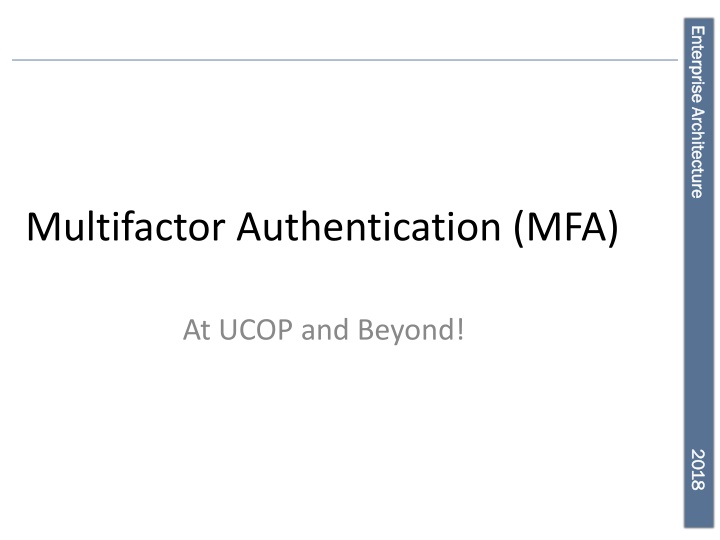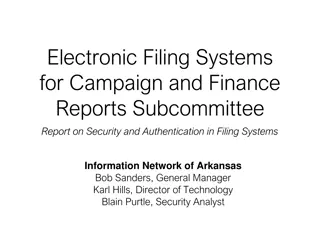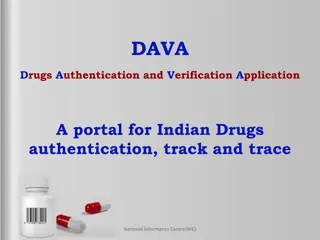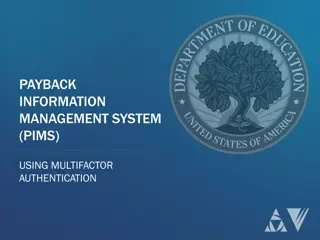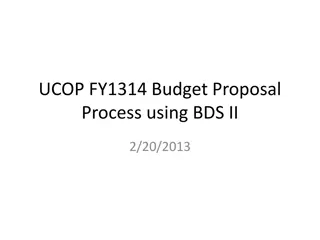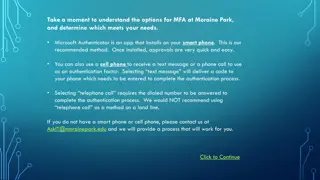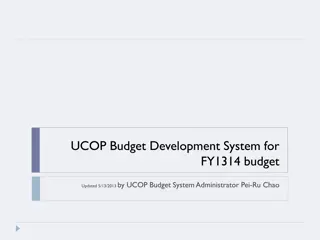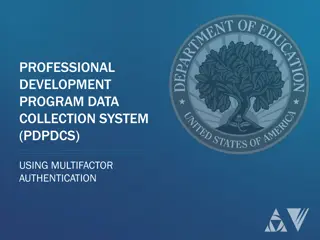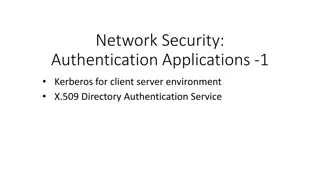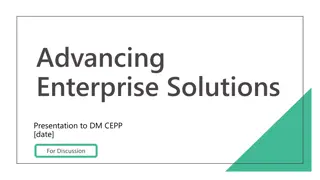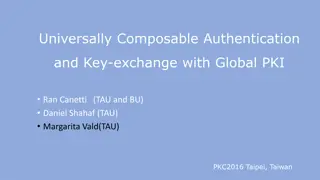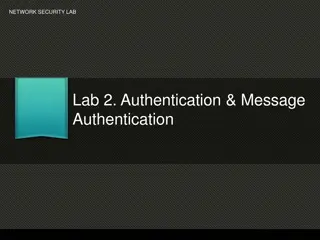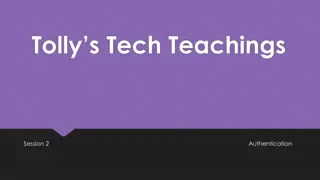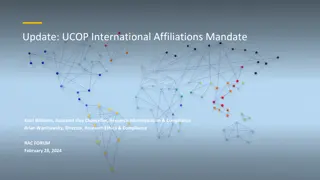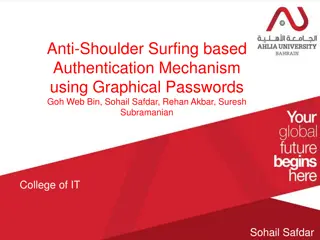Enterprise Architecture Multifactor Authentication: Enhancing Security at UCOP and Beyond
The implementation and importance of Multifactor Authentication (MFA) in enterprise architecture, specifically at UCOP and beyond. Learn about the value of MFA, deployment considerations, factors affecting MFA usage, and challenges faced in MFA deployment. Discover the various types of MFA factors, deployment planning, and foundational choices in MFA adoption. Get insights into the role of MFA in reducing security risks and the evolving landscape of MFA within the enterprise architecture realm.
Download Presentation

Please find below an Image/Link to download the presentation.
The content on the website is provided AS IS for your information and personal use only. It may not be sold, licensed, or shared on other websites without obtaining consent from the author.If you encounter any issues during the download, it is possible that the publisher has removed the file from their server.
You are allowed to download the files provided on this website for personal or commercial use, subject to the condition that they are used lawfully. All files are the property of their respective owners.
The content on the website is provided AS IS for your information and personal use only. It may not be sold, licensed, or shared on other websites without obtaining consent from the author.
E N D
Presentation Transcript
Enterprise Architecture Enterprise Architecture Multifactor Authentication (MFA) At UCOP and Beyond! 2018 2018
Enterprise Architecture Enterprise Architecture Presenters David Rusting UC system-wide CISO Eric Goodman Identity and Access Management Lead Enterprise Architecture Team 2018 2018 2 2
Enterprise Architecture Enterprise Architecture MFA at UCOP (and Beyond!) The value of MFA MFA deployment planning Scoping, constraints and general considerations MFA deployment at UCOP Overview Challenges, issues and lessons learned Comparison of campus MFA programs MFA across UC MFA and system-wide applications How system-wide application requirements (may) differ 2018 2018 3 3
Enterprise Architecture Enterprise Architecture The Value of MFA Half of UC breaches are via credential compromise MFA reduces that risk substantially Has become table stakes for security First factor is usually Something you know Passwords, Security Questions Can be intercepted, guessed, phished. Once stolen, can be used and reused to do bad stuff. Strengthen with a second factor Something you have A phone, a phone number, a key, etc. Something you are Biometrics 2018 2018 4 4
Enterprise Architecture Enterprise Architecture MULTIFACTOR AUTHENTICATION GENERAL DEPLOYMENT CONSIDERATIONS 2018 2018 5 5
Enterprise Architecture Enterprise Architecture Foundational Choices Who will use MFA? Opt-in vs. Required If required, what the criteria? How will you track/audit? Pilots are frequently run as Opt-In UC trend: Required for employees, optional for others Which applications will challenge for MFA? Commonly: Web SSO systems, VPNs Product and supported factors Duo is very common at UC and in higher ed in general App Push, App OTP, SMS text are very common Voice, OTP token and U2F tokens are moderately common Other forms (device or personal certificate) less common 2018 2018 6 6
Enterprise Architecture Enterprise Architecture Factor-specific concerns Factor Factor Pros Pros Password Easy to use Cons Cons Easy to steal Can be easy to guess May be shared (landlines) VOIP not really something you have Users can defeat in novel ways Per authentication fees ($0.04) Iffy security (SS7, # reassignment) Per authentication fees ($0.02) Requires app install (cellphone) Sync issues (sequence) Requires extra keychain item Sync issues (time or sequence) Requires app install (cellphone) Real-time MITM phish still a threat Can be complicated to use Cannot use for all applications Can morph into another "just another password" Voice call Easy to use Ubiquitous OTP via SMS Easy to use Common Easy-ish to use OTP via Software OTP via Token Doesn t require personal device Challenge itself is MITM-proof Strongest security Duo Push U2F/FIDO Token 2018 2018 Bypass Codes Great for Service Desks 7 7
Enterprise Architecture Enterprise Architecture MFA deployment decisions Where and how often are challenges presented? Often more coordination and explanation than decision Remember Me can reduce challenges for web-based logins Non-web apps often manage their login sessions uniquely Can still be effectively unpredictable for most users How will onboarding be managed? Self-service: User driven In-line: Forced at login Ramp-up: Separate registration and challenge processes 2018 2018 8 8
Enterprise Architecture Enterprise Architecture MFA security considerations "Trusted Networks" Do I need MFA if I'm onsite (or virtually onsite via VPN)? Threats: Open networks, lateral attacks, password sharing Implementation approach varies Non-"second factor" factors Backup codes (esp. long lived and/or reusable) Limited use/short term are common for service desks Bypass mode Most locations avoid use VOIP phones, Google Voice, etc. Fail Open vs. Fail Closed What do to if the MFA service itself is non-responsive? 2018 2018 9 9
Enterprise Architecture Enterprise Architecture MULTIFACTOR AUTHENTICATION DEPLOYMENT AT UCOP 2018 2018 10 10
Enterprise Architecture Enterprise Architecture MFA at UCOP: Overview UCOP user population 2000 employees and contractors with UCOP accounts All local users are employee-like Over 1000 non-UCOP UC employees with UCOP accounts MFA Product Selected Duo as the vendor Allowed factors evolved over the course of deployment Deployed in two phases Pilot deployment Full population deployment 2018 2018 11 11
Enterprise Architecture Enterprise Architecture MFA at UCOP: Pilot 2016 Pilot project targeted specific apps and users Applications integrated Citrix/"Cloud Desktop" Outlook Web App (web mail) Users ITS only Largely deployed as self service (train yourself) Users self-registered (opt-in style) Some experimentation with factors Technically complex integration Involved multiple authentication technologies 2018 2018 Fairly low user impact Many users never saw MFA challenge 12 12
Enterprise Architecture Enterprise Architecture MFA at UCOP: Full deployment 2017/2018 Full rollout of MFA Integrated MFA into SSO Effectively added MFA to dozens of applications Users MFA requirement for all UCOP users Extensive training materials and training classes offered Users phased in per department (forced enrollment) over 3-months Changes from Pilot Formalized MFA factor options Added Token support, removed voice and SMS options Formalized onboarding process Token distribution management Onboarding and offboarding workflow coordination with HR and Service Desk Extended SSO session length Enabled Remember Me for 12 hours 2018 2018 13 13
Enterprise Architecture Enterprise Architecture Rollout Issues and Concerns Behavioral Employee resistance to using (or lack of) personal smart phone MFA seen as "extra complexity", "getting in the way" Users sharing passwords User engagement in pre-rollout communications Functional/Process Delivery of (organization owned) phones and tokens And token management generally Onboarding of non- UCOP employee users Maintaining/auditing user MFA status Technical VOIP phones Application MFA integration/interface capabilities Managing (and explaining) frequency of challenges to user 2018 2018 14 14
Enterprise Architecture Enterprise Architecture Campus MFA Rollouts at a Glance (AFAIK) Location Location Who? Who? What? What? LBNL Key Emps+Opt In A,T UCB All Emps+Opt In A,S,V,T UCD Key Emps A,S,V,T UCI Key Emps+Opt In A,T UCLA All Emps+Stu A,S,V,T UCM Key Emps* A,S UCOP All Accounts A,T UCR Opt In A,S,T UCSB Key Emps A,S,V UCSC Key Emps A,S,V, (T) UCSD Key Emps UCSF All Users A, (S, V), T Key Apps When? When? (SSO All Apps All Apps Key Apps Key Apps All Apps Key Apps* All Apps Key Apps None None Pilot (SSO) ) Notes Notes Non-Duo shop 30-day "remember me" Specific non-SSO apps Specific non-SSO apps 2018 2018 A=Smartphone (A)pp Push and/or OTP S=(S)MS Texted OTP V=(V)oice call confirmation T=Physical (T)oken OTP Some Health Center deployments differ from campus configuration 15 15
Enterprise Architecture Enterprise Architecture MULTIFACTOR AUTHENTICATION AS A SYSTEM WIDE SERVICE 2018 2018 16 16
Enterprise Architecture Enterprise Architecture Typical Site-level MFA integration Login happens at SSO server App redirects user to SSO service SSO service "knows" who needs MFA SSO service challenges for MFA if required Potentially a per user/per app configuration Applications trust that correct MFA rule was applied Hey, if the user got here 2018 2018
Enterprise Architecture Enterprise Architecture Silent MFA and system wide apps What if an application specifically requires MFA? App must coordinate user roles with location MFA rules Can be especially complicated for system wide apps If that s not tenable, app can t rely on location s MFA App needs its own MFA solution (cost, complexity) User must sign up for app-specific MFA service (complexity) User may get two MFA challenges per login (annoyance) One from the location SSO service, one from the application 2018 2018
Enterprise Architecture Enterprise Architecture Signaling MFA Higher-ed has defined a fed authN profile for MFA Can be requested when a SAML login is initiated Can be verified as part of the SAML login response Likely to be extended to higher-ed OAuth/OIDC profiles Provides visibility into when MFA is done Better auditing, esp across organizations More flexibility for apps Requires support by both app and SSO service Open discussion about adopting within UCTrust 2018 2018
Enterprise Architecture Enterprise Architecture MFA Specification (Criteria) 2018 2018 20 20
